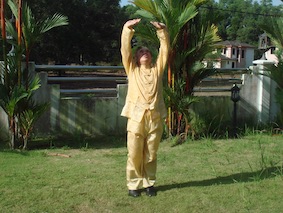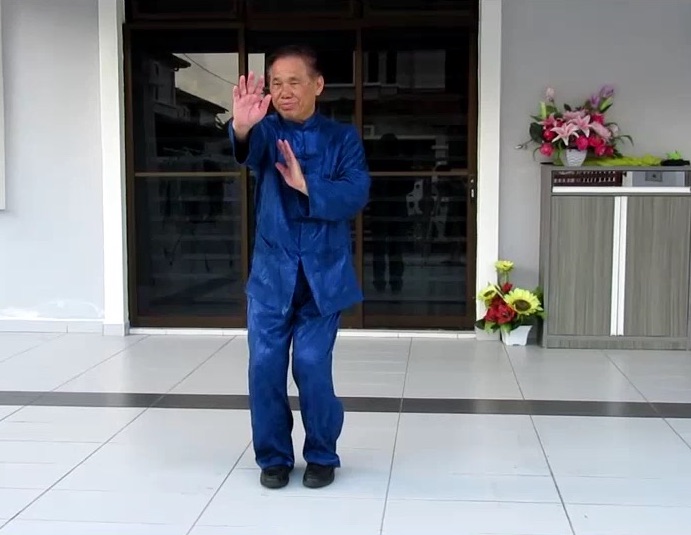SELECTION OF QUESTIONS AND ANSWERS
APRIL 2021 PART 3

Lifting the Sky
Question 1
Can Shaolin Wahnam Chi Kung overcome the coronavirus if someone is infected?
— Dr Foong, Director of Holistic Health Cultivation Centre, Malaysia
Answer
I believe that Shaolin Wahnam chi kung can overcome any disease. If there is chi, there is life.Question 2
Will genuine Chi Kung able to prevent infection of the virus? If yes how could someone able to achieve such ability, and what is the best exercise or pattern for prevention?
Answer
Genuine chi kung should be able to prevent the infection of the virus, otherwise it is not chi kung. Unfortunately, more than 80% of so-called chi kung practitioners, including so-called masters, are not practicing genuine chi kung; they only practice gentle physical exercise which does not overcome illness, and does not contribute to good health, vitality and longevity.
How effective is genuine chi kung against the virus depends on how powerful the genuine chi kung is, and how virulent is the virus. Surprisingly, overcoming illness, like the coronavirus, cancer or heart disorders, does not need powerful chi kung. Self-Manifested Chi Movement, Five-Animal Play and 18 Jewels are excellent to overcome the illness, or any illness.
If a practitioner has a lot of internal force, he will not be infected by the virus or have any illness. But internal force has to be developed gradually. He will also not be a carrier of the virus, as the virus will be destroyed.
If a practitioner practices our chi kung regularly, he will have the ability to prevent the virus. A good exercise is "Lifting the Sky" or "Carrying the Moon", followed by a gentle chi flow.
He should continue to develop internal force, which contribute to peak performance and longevity. By continuing to practice "Lifting the Sky" and "Carrying the Moon" he can develop some internal force. He can achieve better result if he practices "Pushing Mountain". If he has the chance, he can practice "Cosmic Breathing" and "Sinew Metamorphosis".
In Shaolin Kungfu and Taijiquan, "Three-Circle Stance" and "Golden Bridge" are excellent in developing internal force. Later he can progress to "Eighteen Lohan Art" and "Iron Wire", or any force-training exercise.

"Reverse Hanging of Double Hooks" from the Eighten Lohan Art
Question 3
When a chi kung healer treating this type of infected patient, does the patient need to be isolated from a glass room or is it better to conduct chi kung over video internet?
Answer
As the virus is contagious and fatal, it is better not to treat patients with the disease. This may sound selfish, but if people do not believe in chi kung, or only come to chi kung as a last resort, we do not have any obligation to treat them.
Actually we are very generous. We share secrets openly.
Question 4
Should I treat this type of patient? Or should I conduct a chi kung course to help people prevent being infected?
Answer
I would strongly advise you not to treat patients with the disease. You should focus on helping the super-rich to be healthy.
Chi kung has to be practiced regularly. We should not treat just this disease. When a person practices chi kung regularly, not only he is not infected by this virus, or any virus, he should have good health, vitality, longevity, peak performance and spiritual joys. Chi kung is a way of life.

"Golden Axe Strikes Mountain" from Three-Harmony Set
Question 5
I have been suffering from swollen feet for 30 years now.
I don't remember properly how to use the waterfalls of light to heal our sickness. Do we need to feel the chi from the dan tian?
— Renuka, Australia
Answer
By the way, have you attended my Intensive Chi Kung Course? If you haven't, you should make it a point to attend. If you practice chi kung, your swollen feet should go away.
Let me share with you a saying. "If you are accomplished in the Shaolin arts, it is better than changing stones to gold by touch". At first I thought the saying was much exaggerated, but gradually I find there is much truth in it. Our chi kung is from Shaolin.
It may take some time, but gradually you will have good health, vitality and longevity. You will also have peak performance and find every day peaceful and happy.
Focus on the first day of the Intensive Chi Kung Course. The second day is for peak performance, and the third day for spiritual cultivation, like being peaceful and happy.
Just perform about 10 minutes a session, two sessions a day, once in the morning and the other time in the evening or at night.
The onus of chi kung is energy flow. You can generate a gentle energy flow with "Lifting the Sky", or "Carrying the Moon", or "Pushing Mountain".
Once awhile, say two or three times a week, you can perform all the three exercises together, but the time is still about 10 minutes. You have to go faster and faster. You use form to generate a gentle energy flow.
Our chi kung is very powerful; just about 10 minutes a session is sufficient. If you perform more, you may over-train.
There is no need to think of the waterfall or light from the dan tian, or energy field, when you practice our chi kung. Don't add anything. Just perform the exercises every day the way you will learn at the course, and you will have good health, vitality, longevity, peak performance and spiritual joys.
Question 6
I hope that I did not come across as impolite or ungrateful for not responding to the Wudang Three-Harmony Set.
— Sifu Chris Didyk, Shaolin Wahnam USA
Answer
The Wudang Three-Harmony Set was an inspiration.
I recalled that Sun Lu Tang did not earn his reputation for nothing; he was known as the "Young Grand Guard", and was well known in kungfu circles.
He could have hidden secrets in the open. Indeed he did, as manifested in the Wudang Three-Harmony Set.

Avoiding a Side Kick from "Striking Hands"
Question 7
There is no bearing on your advice that learning the 16 Shaolin or 12 Taijiquan Sequences is more important and beneficial than learning the Wudang Three-Harmony Set and combat applications.
Answer
The 16 Shaolin Basic Combat Sequences and the 12 Taijiquan Combat Sequences are a treasure. They were the result of my many years in teaching at Shaolin Wahnam Association, and later the 12 Shaolin Basic Sequences were streamlined and expanded into 16, whereas the Taijiquan combat sequences remained at 12 but were also streamlined.
I recalled a student once told me the following incident. His assistant instructor of a former school, who was the eldest son of the master, inquired what he had learned at Shaolin Wahnam Association, and punched out a middle-level fist at him. Automatically my student responded with "Lohan Tames Tiger". The assistant instructor was helpless, and they were shocked -- my student probably more than the assistant instructor.
You could easily respond with "Hide Flower in Sleeves" from the 16 Shaolin Basic Combat Sequences or "Eagle Claws Catch Snake" from the 4 Taijiquan Abridged Combat Sequences, or any other technique.
"Basic" in the 16 Shaolin Basic Combat Sequences or the 12 Taijiquan Combat Sequences is a misnomer, giving the impression that the combat sequences are elementary. The sequences are actually quite advanced; most people would not know what to do when the sequences are applied on them. I use the term "basic" because it forms the base of what Shaolin Wahnam kungfu practitioners should know.
All Shaolin or Taijiquan practitioners in our school should know these 16 or 12 combat sequences. After that they can specialize in the Wudang Three-Harmony Set, or any other set. By this time, they will be able to formulate their own combat sequences.
The 12 Taijiquan Basic Combat Sequences are just fantastic. I formulated the 16 Shaolin Combat Sequences first, then the 12 Taijiquan Combat Sequences. That meant the Taijiquan combat sequences should have benefited from the Shaolin sequences.
Taijiquan is actually a specialization of Shaolin Kungfu. It employs gentleness against brutal strength, and is triple cultivation. When I learned Shaolin Kungfu, I had to perform kungfu, chi kung and meditation separately. When you practice Taijiquan, you perform them together.
Question 8
Sifu, I have to say that the Taijiquan sequences, and the Wahnam Taijiquan curriculum for that matter, are just fantastic. They exceed my already-high expectations. I especially like the Pushing Hands -> Striking Hands -> Combat Sequences progression.
Answer
Pushing Hands in Taijiquan is an ingenious innovation. It is meant to develop combat skills, like being relaxed, flowing with the opponent's momentum, and developing internal force. Most Taijiquan practitioners today, or Taiji dancers, miss these skills. The fact that there are weight divisions in Taijiquan Pushing Hands defeat the principles of Taijiquan.
You must also practice Striking Hands. While Pushing Hands develop skills, Striking Hands focuses on techniques. It is a common misconception that if one is good at Pushing Hands, he is good at combat. He may be skilful, but he still needs techniques.
Your students are very lucky. But they must spend sufficient time to learn skills and techniques. You must also charge high fees. Remember that it took me a year in my student's days to acquire what a typical Shaolin Wahnam student gain in a month. Most other students just perform physical exercises in Shaolin or Taijiquan forms.
If you have any questions, please e-mail them to Grandmaster Wong via his Secretary at secretary@shaolin.org stating your name, country and e-mail address.
LINKS
Selected Reading
- Eighteen Lohan Art
- Secrets in Chi Kung and Kungfu
- The Amazing Intensive Taijiquan Course
- Why Shaolin Kungfu is the Greatest Martial Art
- Simply Delicious
